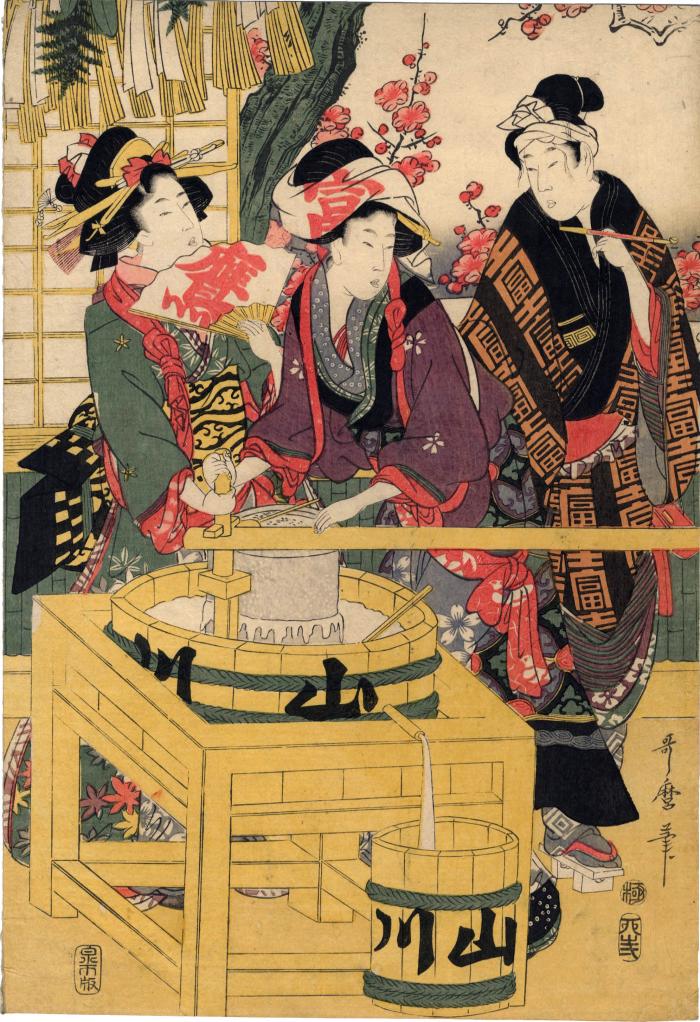Kitagawa Utamaro II (二代目喜多川歌麿) (artist ca 1750 – 1831)
Famous Product: Mount Fuji White Saké (Meibutsu fuji no shirozake - 名物富士の白酒) - left-hand panel of a triptych
1807
9.875 in x 14.375 in (Overall dimensions) Japanese woodblock print
Signed: Utamaro hitsu (哥麿筆)
Publisher: Izumiya Ichibei
(Marks 180 - seal 25-365)
Censor's seal: kiwame
Date seal: 11/1807
Mead Art Museum, Amherst - full triptych ascribed to Utamaro I
Adachi Museum - full triptych
Museum of Fine Arts, Boston - a similar triptych by Toyokuni I - ca. 1795-1801
University of Michigan - the full triptych Is this a glorified advertisement in print form? Possibly. Yamakawa (mountain rivers - 山川) which is still the name of a distillery in Japan.
The full copy of the triptych in the collection of the Mead Art Museum at Amherst states that it is by Utamaro I who died in 1806, but even they note that the date of this composition is from late 1807. The title of this piece appears in the banner on the right-hand panel, which is not present here. They identify the male figure in the left panel, the same one as in the Lyon Collection seen here, as a tōji (杜氏) or saké brewer. In Saké: A Drinker’s Guide it notes that “Even today, tōji observe the Shinto rituals of brewing saké, and it seems highly likely that the brewmasters of the Edo period preserved this time-honored title for their rank in the hierarchy of the kurabito.”
While the inclusion of beautiful women was standard for this time, there is another connection - probably not a conscious one in 1807 - with the production of saké in ancient times. Members of the community would get together, chew nuts and grains and spit them out into a large tub. The saliva would help create the enzymes which along with air borne yeast would result in something akin to the saké we know today. In fact, the original tōji were women and virgins had been chosen to do the chewing and spitting in the process of saké brewing. Virgins were believed to be closer to gods and therefore blessed.
****
Is this a print by Utamaro or his successor Utamaro II?
Shūgō Asano in The Passionate Art of Kitagawa Utamaro wrote on pages 67-68 of the text volume: "Shortly after Utamaro's death, Koikawa Harumachi II (dates unknown) is thought to have taken the name Utamaro II. Works from 1807 onwards which bear date seals giving the year and month are obviously by Utamaro II. When works do not have these date seals, it is not always easy to separate late works by Utamaro I from early works by Utamaro II. However, it is in fact generally possible judging by: differences in style; differences in signature (including the use of subsidiary art names, go; differences in the fashions and customs depicted."
This print in the Lyon Collection clearly shows the date seal for the 11th month of 1807.(JSV)
****
There is another copy of the Museo de Arte Carrillo Gil.
beautiful woman picture (bijin-ga - 美人画) (genre)
Izumiya Ichibei (和泉屋市兵衛) (publisher)
Mount Fuji (富士山) (genre)
